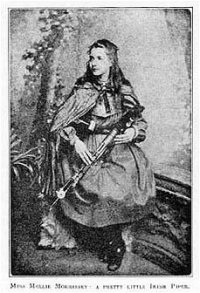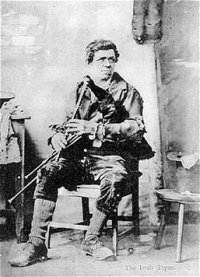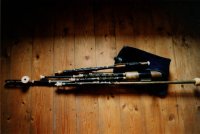
|
Irish
Uilleann Pipes |

|
How old are the Uilleann pipes?
Native to Ireland, Uilleann pipes date back almost 300 years to the beginning of the 18th century and probably share some common ancestry with Scots lowland pipes and other bellows blown pipes of the region. The design of the pipes as we know them today, with three drones and three regulators, stabilized around the start of the 19th century. Yet they nearly became extinct, and were saved by the efforts of the Taylor brothers and Captain Francis O'Neill in Chicago in the early 20th century, and later in Ireland by Leo Rowsome, Séamus Ennis, Johnny Doran and Willie Chancy, and others who helped promote the instrument up through the 1960s. Today Uilleann pipes are enjoying a continued revival in Ireland, North America and Europe and are more popular than ever, yet they remain extremely rare when compared to other instruments.
Are they loud?
No. Uilleann pipes are normally no louder than a fiddle or accordion and sometimes much quieter, depending on the pitch, the style of the player (how the pipes are adjusted), and the particular instrument.
Are they bagpipes?
Technically, yes. But they have nothing in common with the famous Highland Bagpipes, or "bagpipe," which everyone associates with kilts and parades and all the paraphernalia. For example, Uilleann pipers do not wear kilts. Nor do they parade. The Great Highland Bagpipes are a martial instrument meant strictly for the out of doors and have virtually no direct relation to Uilleann pipes.
What's the difference between the Bagpipes and Uilleann Pipes? 
Highland Bagpipes are played standing, Uilleann pipes are played sitting. Highland Bagpipes are for the outdoors, Uilleann pipes are for indoor playing. Highland Bagpipes are a military instrument. Uilleann pipes are a social instrument. The Highland bagpipes are usually taught according to strict methods with standardized ornamentation and learned by rote from written music and judged in competitions. By contrast, Uilleann pipes are free of such standardization and are played in a wide variety of styles; individual players create their own versions of tunes and their own use of ornamentation, which will vary from player to player. Finally, Uilleann pipers don't normally learn from sheet music but learn by ear within their tradition. And most Uilleann pipers do not enter competitions, which are considered meaningless by many and even counterproductive.
How do Uilleann pipes compare with other bagpipes?
Among the hundreds of bagpipes that were once in existence, as well as those that survive today, Uilleann pipes are the most evolved and the most complex.
Why are they so rare? Are they difficult to play?
Uilleann pipes are very difficult to play. The difficulties of learning Uilleann pipes are typically partly mechanical. They are a daunting musical challenge to master. Until recently, it was also difficult to obtain a set of Uilleann pipes.
What about range, reeds and the name Uilleann?
Uilleann pipes play two full octaves and are capable of all the half-steps between, offering the widest range of notes of any form of bagpipe in the world. This is accomplished by the use of dry reeds. The bag is inflated with a bellows attached to one arm, thus the term Uilleann, which means "elbow" in Irish. (Although the historically correct term may be Union Pipes, referring to the union of sounds.) Dry reeds respond differently than the wet reeds found in most forms of bagpipes where the player inflates the bag with breath. This allows a finer reed in the Uilleann pipes, one capable of overblowing into the second octave. The second octave has a unique, very sweet tone which is part of the defining character of the instrument. This ability to play in a normal musical range allows one to play just about any type of music on the Uilleann pipes, including jazz, rock, and classical music, all of which have been done in recent years.
How many actual pipes are in a set of Uilleann pipes? 
Seven, normally. The chanter plays the melody and is capable of two octaves. There are typically three drones, each an octave apart, which may be switched on or off. A major distinction of Uilleann pipes is the three pipes which overlay the drones and are somewhat equivalent to stopped organ pipes. These are called regulators and each one has 4 or 5 keys which play notes when pressed. These harmonize with the drones and chanter. This makes a total of seven pipes in a typical set. The regulators may be played singly or together to create chords for accompaniment to the melody played on the chanter. There are many traditional styles of Uilleann piping and some favour regulator playing, while others play them infrequently or not at all.
Are Uilleann pipes played in America? Are they made in America?
Yes, they are played in America. Very much so. About a hundred years ago a famous set of brothers from Ireland named Taylor settled in the US and made many sets of pipes which were very influential on the evolutionary refinements and experiments in pipe design at that time, particularly in modern concert pitch which was a new development during that era. These American-made pipes are highly prized and are still being played today. There were others who made pipes in North America as well, and it continues today. Some very fine players are American-born, like the charismatic Denis Brooks, founder of the San Francisco and Seattle Pipers Clubs in 1975 and 1981, respectively. A photo and short description of the very first Seattle Club meeting is available here. A photo of the first San Francisco Club meeting is here. We plan to have more historical photos of the American pipers clubs here in the future.
There is an interesting transcripted interview by Peter Browne on his RTE Ireland programme "Sounds Traditional" with Todd Denman that mentions some of the difficulties facing American pipers and Todd's early experiences learning the pipes.
Where can I hear Uilleann pipes?
You can hear Uilleann pipes at various concerts and on many recordings widely available, for example on many of the Aniar Records releases (sponsor of this site) or by listening to the sound files below. You can also see a list of Uilleann pipes recordings at NPU.
Tionóls, or gatherings, take place several times a year in Ireland and North America, as well as Holland, Germany and England.
In North America. On the American west coast the tionól takes place every February on Valentine's weekend and alternates between Seattle and San Francisco. It is the longest running Uilleann piping event in North America. One of the highlights is the Saturday night concert which features Uilleann pipers and musicians on fiddle, flute, whistle, and so on. For more information about the west coast tionól see San Francisco Tionól and the San Francisco Pipers Club Page and The Pipers Club in Seattle. The next Tionól is scheduled for Seattle, February 2000. The 1999 Tionól was in San Francisco February 12- 14, 1999. There is also an East Coast Tionól every October (anyone have a link?).
In Ireland and Europe. The sponsoring body for events is the pipers club located in Dublin, known as Na Píobairí Uilleann, (The Uilleann Pipers). NPU often holds concerts, recitals and other public events. See the NPU Events Calendar which lists most Uilleann piping events around the world. NPU also maintains a large listing of Uilleann pipes recordings and related publications.
Where can I find more information?
See NPU, Na Píobairí Uilleann, (The Uilleann Pipers) NPU sponsors many regular events in Ireland, publishes a newsletter, and has a catalogue of recordings and publications. Or write: Na Píobairí Uilleann, 15 Henrietta Street, Dublin 1, Ireland. Email: npupipes@iol.ie. The Pipers Club in Seattle offers membership, a national newsletter serving North America, and other publications. Or write to The Pipers Club, PO Box 31183, Seattle, WA 98103. Email: ipc@wolfnet.com. The San Francisco Pipers Club offers membership, regular meetings, lessons and a local newsletter.
Uilleann pipes slow airs: Looking Back, MP3, or the lo-density files: My Lagan Love, .au or .wav played by Todd Denman from the CD Like Magic.
Uilleann Pipes links:
Thanks to Aniar Records for sponsoring this page and related piping pages.
All titles, artwork, text and photos herein copyrighted by Aniar Records or are in public domain or used by permission. Copyright © 1997-1999 Aniar Records. Unauthorized use of materials prohibited.